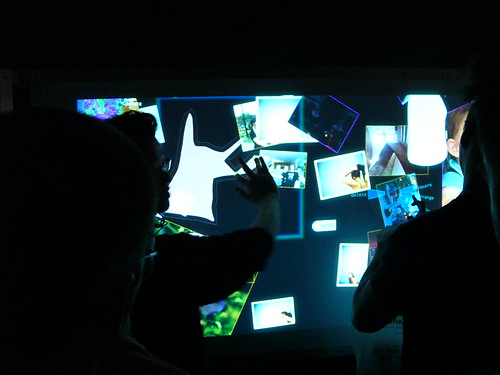
Popularized with the ever-present iPhone and expanding into the tablet and desktop sector by companies such as Dell and HP, multitouch is becoming an interesting addition to today’s user interfaces. Overseas companies, such as Asus, are also taking advantage of the technology in new inexpensive tablets; even Gateway is offering a mulititouch tablet these days. Despite the popularity of multitouch, especially on the mobile platform, it seems like a technology with stunted growth and limited applications.
Key points (if you’re too lazy to read the article)
- Today’s interfaces are not designed for multitouch
- Multitouch would require redesigning and rethinking of most GUIs
- Multitouch often wastes screen real estate
- With multitouch, one often can’t see what’s under one’s finger
- Multitouch requires larger on-screen items for finger interaction
- Do we need multitouch? What advantages does it pose?
- Multitouch provides a more organic interface between human and computer
- Multitouch allows simultaneous on-screen manipulation of multiple objects
No GUI Support
Most modern GUIs have little to no support for multi-touch technology. One prime example of this is Windows 7, which came with multitouch built-in, but the software updates have little impact on end-user experience. Multitouch is still limited to a specific audience in Windows 7, as navigating through the “All Programs” in the start menu, clicking on links in web pages, and using system tray icons are all quite challenging using one’s fingers. Also, multitouch gestures are not well-implemented into the operating system. To be extremely effective, Windows should have bindings for custom gestures, or at least include more default gestures for the base operating system itself.
Current applications are also severely limited with multitouch interactions, as most applications available today have small hard-to-tap virtual buttons. Including larger buttons wastes screen real-estate and can be a bit unsightly. Many applications also require keyboard input to accomplish a variety of functions. It would be extremely challenging to implement numerous keyboard-based functions into on-screen gestures and buttons. One other prominent issue with touchscreens in general is that one’s finger obscures the item that is being clicked, which makes clicking small objects extremely challenging.
No Need
Next comes the big question: do we really need multitouch? Many people have the opinion that navigation is much faster with a keyboard and mouse than a touchscreen. This is true for most applications, such as web browsing that involves a good deal of typing and link-clicking.
Advantages
Despite the downsides stated, multitouch does provide some advantages to human-computer interaction. For instance, multitouch allows manipulation of multiple objects, or multiple characteristics of objects, at the same time. One simple example of multi-object interaction would be a digital soundboard, where sliders and dials must often be adjusted simultaneously. This would be impossible using a single mouse pointer, and would not allow precise control of speed with a keyboard.
Multitouch also provides for more organic interaction with computers, allowing the manipulation of digital data in a more physical manner. This interaction could be flipping through photos, organizing files, or moving windows around the desktop.

Leave a Reply